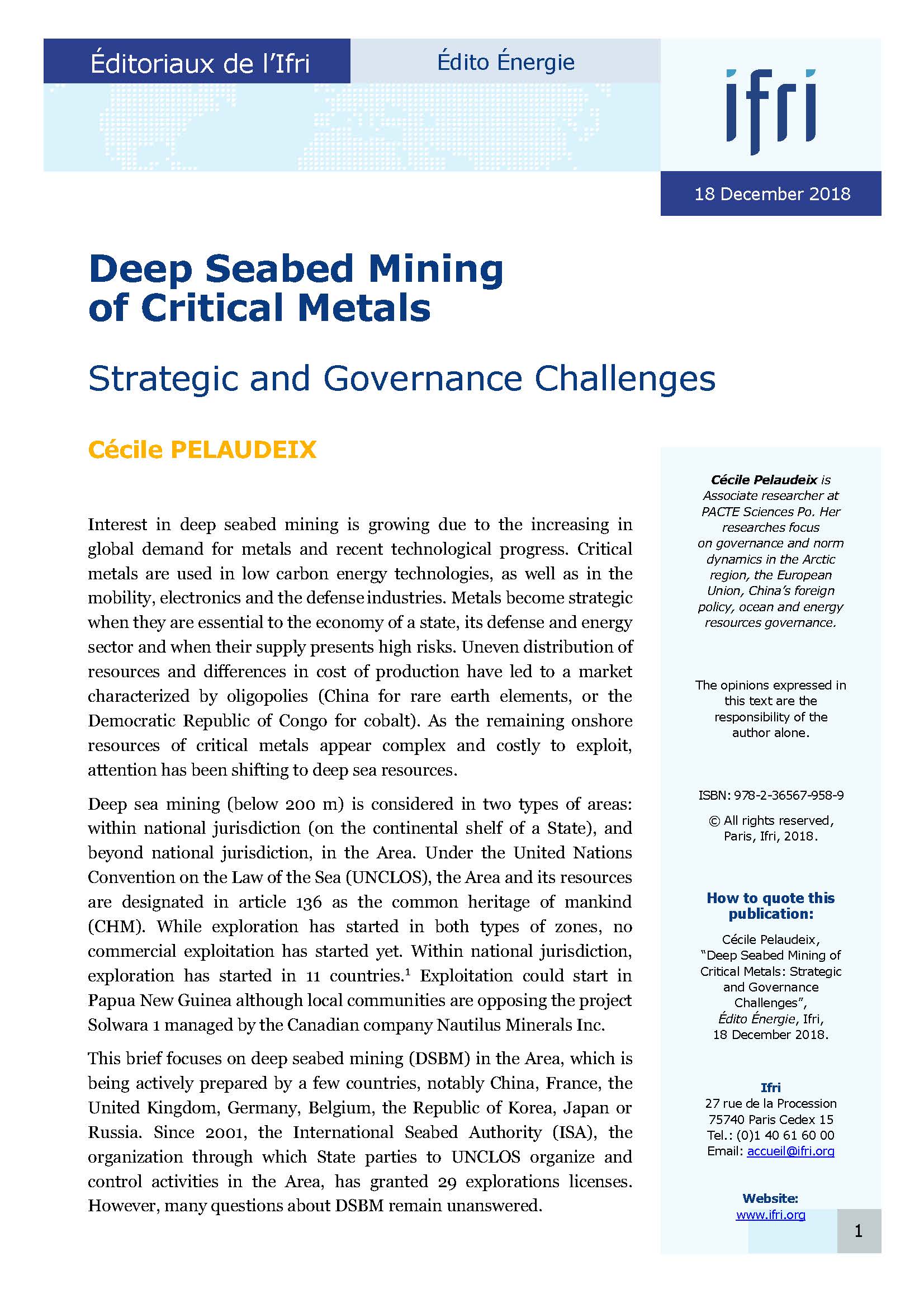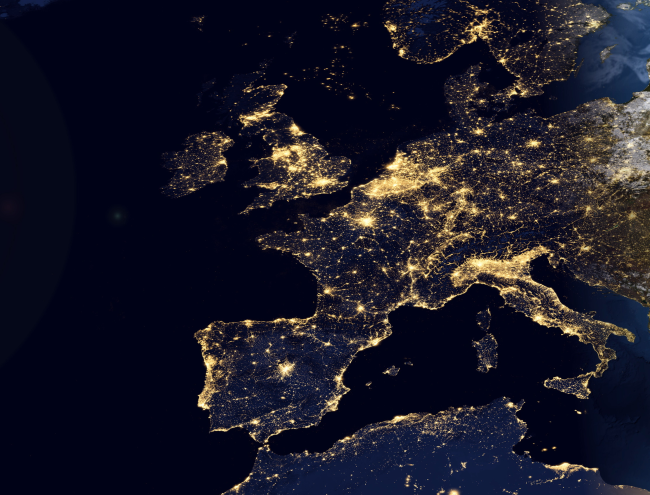Deep Seabed Mining of Critical Metals: Strategic and Governance Challenges

Interest in deep seabed mining is growing due to the increasing in global demand for metals and recent technological progress. Critical metals are used in low carbon energy technologies, as well as in the mobility, electronics and the defense industries. Metals become strategic when they are essential to the economy of a state, its defense and energy sector and when their supply presents high risks. Uneven distribution of resources and differences in cost of production have led to a market characterized by oligopolies (China for rare earth elements, or the Democratic Republic of Congo for cobalt). As the remaining onshore resources of critical metals appear complex and costly to exploit, attention has been shifting to deep sea resources.
Deep sea mining (below 200 m) is considered in two types of areas: within national jurisdiction (on the continental shelf of a State), and beyond national jurisdiction, in the Area. Under the United Nations Convention on the Law of the Sea (UNCLOS), the Area and its resources are designated in article 136 as the common heritage of mankind (CHM). While exploration has started in both types of zones, no commercial exploitation has started yet. Within national jurisdiction, exploration has started in 11 countries. Exploitation could start in Papua New Guinea although local communities are opposing the project Solwara 1 managed by the Canadian company Nautilus Minerals Inc.
This brief focuses on deep seabed mining (DSBM) in the Area, which is being actively prepared by a few countries, notably China, France, the United Kingdom, Germany, Belgium, the Republic of Korea, Japan or Russia. Since 2001, the International Seabed Authority (ISA), the organization through which State parties to UNCLOS organize and control activities in the Area, has granted 29 explorations licenses. However, many questions about DSBM remain unanswered.
Deep seabed resources and sponsoring states
The 2017 European Union (EU) list of critical metals now includes 27 elements. Critical metals are mainly found within three kind of minerals: the polymetallic nodules (PN), polymetallic sulphides (SU) and cobalt-rich ferromanganese crusts (CO). They can be found in all oceans. The deepest (between 3 500 and 6 500 m) are the PN, which in addition to copper, nickel and cobalt, contain more rare metals than earth deposits. SU with economic potential (between 1 500 and 3 500 m) are very rich but distributed unevenly and their inventory along the 60 000 km ocean ridges remain incomplete. CO (from 400 to 4 000 m) are on average three times richer in cobalt than earth deposits, and contain lots of platine as well.
The ISA has opened areas for exploration in the Pacific, the Atlantic and the Indian Oceans. It has entered into 15-year exploration contracts with 29 contractors (States, publicly-funded companies or institutions and private companies) (see fig. 1). Most of the contracts (17) are for exploration for PN in the Clarion-Clipperton Fracture Zone (CCFZ) in the Pacific: in this area, the mass of the nodules accounts for 34 billion tonnes, equivalent to 7.5 billion tonnes of manganese, 340 million tonnes of nickel, 275 million tonnes of copper and 78 million tonnes of cobalt.
Figure 1 only accounts for DSBM in the Area. It does not reflect the importance that States ascribe to deep sea mining in general. The French Polynesian EEZ for example has a high potential of CO. Except for China, the general objective of industrial policies and research & development is to reduce the dependency to critical metals. Before exploitation starts, many challenges remain to be solved: technical, environmental, economic.
In 2020, China will begin a global deep-sea scientific exploration mission with the Jiaolong, its new manned deep-sea submersible: China is now the fifth country with deep-sea exploration technology, after the United States, France, Russia and Japan. ‘Seabed 2030’ is a collaborative project between the Nippon Foundation and GEBCO which aims to bring together all available bathymetric data to produce the map of the world ocean floor by 2030 and make it available to all.
Exploration and exploitation challenges
Technological challenges are due to the depth and remoteness of operations. The excavation techniques are not operational for CO which are hard to cut, but they are available for SU, and progressing well for collecting PN: according to Amundi, the most promising technology developments are to be found in the countries of South Korea, Belgium, China and Singapore.
Environment challenges are particularly concerning. The preservation of the marine environment from the direct impact of extraction (including the water column) presents daunting challenges; extracting metals could impair the important role that the metals have in the biological activity and carbon cycle of the oceans; and restoring the ecosystems appear accordingly very complex, if not impossible.
Important economic challenges are at stake. The economic value of deep-sea metals is subject to the fluctuation of commodity prices. In addition to operational expenditures, very high prefeasibility expenses are to be considered, as well as the cost of site rehabilitation. And there is a critical knowledge gap in terms of understanding the economic services of the deep-sea ecosystems. Expected economic benefits also depend on the value chain that a country has, from extraction to transformation, to the production of semi-finished products, to finished products and to recycling. China stands as an exception as it masters four steps of the value chain whereas many countries only control one or two steps of the value chain (e.g. France, while Germany controls three steps).
Although a few countries are eager to start exploitation soon, the mining code for exploitation is not yet completed. Until then, it is not possible for parties to start mining exploitation in the Area. Governance challenges are manifold and conflicting, such as when prioritizing the environmental and economic security issues which do not have the same importance amongst parties.
The next governance challenge: preparing the mining code
The 168 members of the ISA form an assembly that elects 36 representatives to serve on the Council: countries are distributed in 5 groups, reflecting both geography and interests. The Council approves mining contracts, elects experts in mining, science and law to serve five-year terms on the Legal and Technical Commission (LTC). The 30 members of LTC review mining applications, draft regulations, supervise mining companies and assess the environmental impact of such activities. A Legal Working Group of twelve experts was formed in 2017. Yet, the agreed target date for the completion of the mining code is 2020. Many aspects still need to be worked out.
The concept of CHM, and its principles, are not yet operationalized. The ‘benefit’ of mankind is described in UNCLOS as the “equitable sharing of financial and economic benefits derived from activities in the Area” (art. 140). Yet the ISA has not decided on a finance model for the sharing and use of revenues. The entity which should institutionalize the distribution of benefits has not been established. UNCLOS requires that the Authority and States “cooperate in promoting the transfer of technology and scientific knowledge (art.144). States shall also act “in the interests of maintaining peace and security and promoting international cooperation and mutual understanding” (art. 138). Yet, cooperation between States is limited.
A balance between protection of the environment and resources exploitation requires to elaborate proper environmental impact assessment tools, based on an ecosystem-approach, to consider biological diversity, reduce risks, develop new remote monitoring and assessment tools and technologies, ensure enforcement of regulations, design and management of marine protected areas, and to establish rules for liability for environmental harm. Public participation has to be considered.
Another shortcoming is the special judicial system centered on the Seabed Dispute Chamber which is not as comprehensive and robust as it should be, and should be dealt with by the ISA. Finally, imbalances between rights of ISA members and non-ISA members (e.g. States who have not joined UNCLOS, like the United-States) should still be considered: non-members can become free riders on the convention and could strongly harm the institution since they are free of obligations.
Conclusion
The mining code for exploitation of deep seabed minerals could become another milestone in the governance of the oceans. No rush should thus preside to its drafting. The oceans are already under huge pressure not least from climate change. In accordance with UNCLOS provisions, a balance with disadvantaged States, particularly in the context of globalization, needs to be ensured. It is important that the ISA succeeds in its mandate, so that multilateralism plays its role and delivers large benefits. Moreover, should the DSBM regime become international customary law, it would apply to non UNCLOS parties. In consequence, states should encourage public debates, including on the principles of CHM, the precautionary principle and the polluter pays principle. The EU, as a party to ISA, could clarify its position. The ISA should also consider the institutional changes required by the need to promote interstate cooperation and establish dispute settlement mechanisms.
Download the full analysis
This page contains only a summary of our work. If you would like to have access to all the information from our research on the subject, you can download the full version in PDF format.
Deep Seabed Mining of Critical Metals: Strategic and Governance Challenges
Related centers and programs
Discover our other research centers and programsFind out more
Discover all our analysesBrazil One Year Away from the October 2026 General Elections
Brazil’s general elections will be held on October 4, 2026, to elect the president, vice-president, members of the National Congress, governors, deputy governors and state legislative assemblies. For the presidential and gubernatorial elections, a second round will be held on October 25 if no candidate obtains a majority of the votes in the first round.
COP30: An Inflection Point for Climate Action and Governance
The 30th Conference of the Parties (COP30), opening in Belém, Brazil, on November 10th 2025, convenes at a perilous moment.
The Strategic Dimension of Skills in the Clean Industrial Deal
In the competitiveness and energy transition battles, the European Union (EU) must master a determinant factor: skills.
The Energy Transition Faces Geopolitical Challenges. How Can Ideological Divides Be Overcome?
President Trump’s positions and policies, combined with record coal consumption and booming global electricity demand, geo-economic confrontation, and widespread concerns about energy security, are changing the game when it comes to understanding realistic decarbonization trajectories. The war in Europe is intensifying competition between defense and transition budgets. This is also the case elsewhere in the world.










